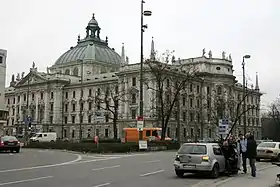Baroque Revival architecture
The Baroque Revival, also known as Neo-Baroque (or Second Empire architecture in France and Wilhelminism in Germany), was an architectural style of the late 19th century.[1] The term is used to describe architecture and architectural sculptures which display important aspects of Baroque style, but are not of the original Baroque period. Elements of the Baroque architectural tradition were an essential part of the curriculum of the École des Beaux-Arts in Paris, the pre-eminent school of architecture in the second half of the 19th century, and are integral to the Beaux-Arts architecture it engendered both in France and abroad. An ebullient sense of European imperialism encouraged an official architecture to reflect it in Britain and France, and in Germany and Italy the Baroque Revival expressed pride in the new power of the unified state.
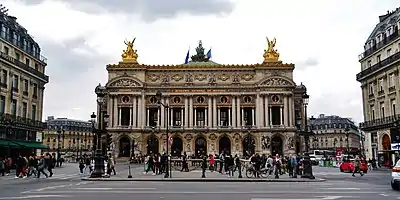

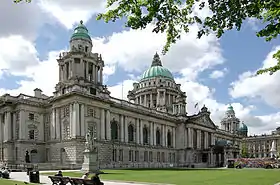
Notable examples
- Akasaka Palace (1899–1909), Tokyo, Japan
- Alferaki Palace (1848), Taganrog, Russia
- Ashton Memorial (1907–1909), Lancaster, England
- Belfast City Hall (1898–1906), Belfast, Northern Ireland
- Beloselsky-Belozersky Palace (1747), Saint Petersburg, Russia
- Bode Museum (1904), Berlin, Germany
- British Columbia Parliament Buildings (1893–1897), Victoria, British Columbia, Canada
- Burgtheater (1888), Vienna, Austria
- Cardiff City Hall (1897-1906), Cardiff, Wales
- Christiansborg Palace (1907–1928), Copenhagen, Denmark
- Cluj-Napoca National Theatre (1904–1906), Cluj-Napoca, Romania
- Ortaköy Mosque (1854–6), Istanbul, Turkey
- Dolmabahçe Palace (1843–1856), Istanbul, Turkey
- The Elms Mansion (1899–1901), Newport, Rhode Island, United States
- National Theatre (1899), Oslo, Norway
- Palais Garnier (also known as the Paris Opera) (1861–1875), Paris, France
- Port of Liverpool Building (1903–07) Liverpool, England
- Rosecliff Mansion (1898–1902), Newport, Rhode Island, United States
- Royal Museum for Central Africa (1905–1909), Tervuren, Belgium
- Semperoper (1878), Dresden, Germany
- Sofia University rectorate (1924–1934), Sofia, Bulgaria
- Zachęta National Gallery of Art (1898–1900), Warsaw, Poland
- St. Barbara's Church (1910), Brooklyn, New York, United States
- St. John Cantius Church (1893–1898), Chicago, United States
- Church of St. Ignatius Loyola (1895–1900), New York City, United States
- Church of Saints Peter and Paul (1932–39), Athlone, Ireland
- Cathedral of Salta (1882), Salta, Argentina
- Széchenyi thermal bath (1913), Budapest, Hungary
- Volkstheater (1889), Vienna, Austria
- National Art Gallery of Bulgaria (the former royal palace), Sofia, Bulgaria
- Wenckheim Palace (1886–1889), Budapest, Hungary
- Stefánia Palace (formerly named Park Club) (1893–1895), Budapest, Hungary
- Gran Teatro de La Habana (1908–1915), Havana, Cuba
- Old Parliament Building (1930), Colombo, Sri Lanka
- House of the National Assembly of Serbia (1907–1936), Belgrade, Serbia.
- Durban City Hall, South Africa
There are also number of post-modern buildings with a style that might be called "Baroque", for example the Dancing House in Prague by Vlado Milunić and Frank Gehry, who have described it as "new Baroque".[2]
Baroque Revival architects
- Ferdinand Fellner (1847–1917) and Hermann Helmer (1849–1919)
- Arthur Meinig (1853–1904)
- Sir Edwin Lutyens (1869–1944)
- Members of the Armenian Balyan family (19th Century)
- Charles Garnier (1825–1898)
Gallery
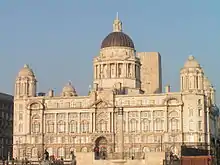 Port of Liverpool (England), 1903–07, by Sir Arnold Thornely, F.B. Hobbs, Briggs and Wolstenholme
Port of Liverpool (England), 1903–07, by Sir Arnold Thornely, F.B. Hobbs, Briggs and Wolstenholme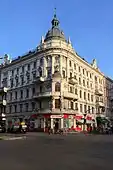 Apartment house in Berlin (Germany), 1889-1892, by Koebe & Weissmüller
Apartment house in Berlin (Germany), 1889-1892, by Koebe & Weissmüller Wenckheim Palace from Budapest (Hungary), 1886–1889, by Arthur Meinig
Wenckheim Palace from Budapest (Hungary), 1886–1889, by Arthur Meinig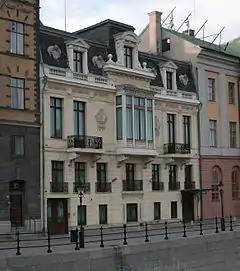 Sager House in Stockholm (Sweden), 1893, by Jean René Pierre Litoux
Sager House in Stockholm (Sweden), 1893, by Jean René Pierre Litoux.jpg.webp)
 Building in Sibiu (Transylvania, Romania), 1892
Building in Sibiu (Transylvania, Romania), 1892.jpg.webp) Window of a small and very beautiful middle-class family city-house in Bucharest, nearby Piața Romană
Window of a small and very beautiful middle-class family city-house in Bucharest, nearby Piața Romană.jpg.webp) Entrance of the house from the previous picture, photoed above the gate
Entrance of the house from the previous picture, photoed above the gate.jpg.webp) Wooden door with pediments of a 1896 house from Strasbourg (France). Even if it is Baroque Revival, it has many Neoclassical ornaments
Wooden door with pediments of a 1896 house from Strasbourg (France). Even if it is Baroque Revival, it has many Neoclassical ornaments.jpg.webp) Wooden door with a round window above it, in Strasbourg
Wooden door with a round window above it, in Strasbourg Entrances of the Direction régionale des Impôts de Strasbourg, each of the doors having a mascaron
Entrances of the Direction régionale des Impôts de Strasbourg, each of the doors having a mascaron.jpg.webp) Double door in the Direction régionale des Impôts de Strasbourg
Double door in the Direction régionale des Impôts de Strasbourg
See also
References
| Wikimedia Commons has media related to Neo-Baroque architecture. |
- "Baroque/Baroque Revival". Buffaloah.com. Retrieved 15 August 2012.
- "The Dancing Building, which Frank Gehry and Vlado Milunic have described as "new Baroque", has divided opinion [...]", in "Architect recalls genesis of Dancing Building as coffee table book published", by Ian Willoughby, 11-07-2003, online at The international service of Czech Radio
- James Stevens Curl; "Neo-Baroque." A Dictionary of Architecture and Landscape Architecture; Oxford University Press. 2000. — Encyclopedia.com . accessed 3 Jan. 2010.
